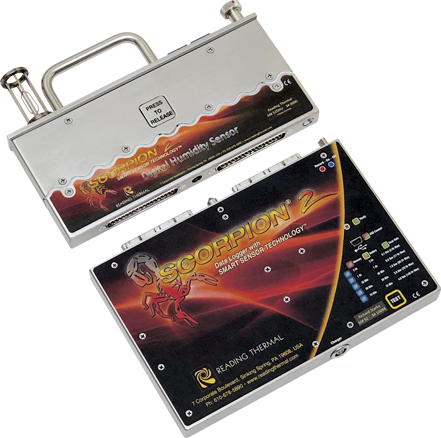Products passing through industrial ovens interact with the amount of moisture in the environment. Measuring humidity with the Reading Thermal Digital Humidity Sensor provides the vital information you need to understand and improve the processes that affect your baked goods.
The experts at Reading Thermal, a Reading Bakery Systems brand, have researched and investigated the commercial baking process for more than 25 years. Our team of heat transfer experts developed the SCORPION® 2 Profiling System and Data Logger, now an industry standard that measures and maps essential baking parameters, such as temperature and humidity, that affect the quality of your products.
How to Measure Oven Humidity
The SCORPION® 2 Digital Humidity Sensor measures the absolute moisture content of the thermal environment in both heating and cooling processes. The sensor travels through the oven with your product, yielding a precise profile of moisture experienced by the product.
Mechanically, the Digital Humidity Sensor includes an Air Temperature sensor, two inputs for Product Core Temperature Measurement, and a proprietary humidity sampling system to measure Dew Point Temperature, Absolute Humidity, and Relative Humidity.
The sampling system contains patent pending Anti-Saturation Technology™, allowing measurements in very high dew point environments, such as steam injection.
The Digital Humidity Sensor is engineered to be compatible with direct gas fired (DGF) ovens. Unlike oxygen sensor technology, which can be off by up to 25% as a result of combustion gases in DGF ovens, the accuracy of the Digital Humidity Sensor remains the same regardless of the oven platform.
Why Humidity Profiling is Important?
Baked products go through three distinct thermal processes:
- The dough is baked after forming to set its structure.
- The product must then be dried to a shelf stable point.
- The product must be adequately cooled before packaging or storage to prevent moisture condensation.
The changes during baking that affect the quality of the final product include time, temperature, and humidity.
- The amount of moisture that remains in a product can affect its shelf life.
- Limiting evaporation can keep the surface of the product moist, allowing it to stretch and preventing cracks.
- Low humidity in a cracker oven can cause blisters that lead to undesirable dark spots and excessive breakage. It may also give the cracker a burnt taste.
- The lack of humidity in a cookie oven can prevent internal moisture from escaping which can lead to checking (the spontaneous cracking of the cookie after baking).
- High humidity in bread ovens produces the desirable glossy crust seen on many bread products. Steam injection is often used to achieve this type of crust.
- High humidity will help kill pathogens, like salmonella, that can be found in surface toppings.
- Product throughput can also be affected by when and how much moisture builds in a process. Moisture laden environments reduce baking efficiency, thereby reducing product throughput.
Explore what is happening inside your industrial bakery ovens. Measuring humidity with the SCORPION® 2 Profiling System and Data Logger and the Digital Humidity Sensor from Reading Thermal can help you improve your products and processes. Contact us online, or call us at (610) 678-5890 Ext. 2 to learn more.

